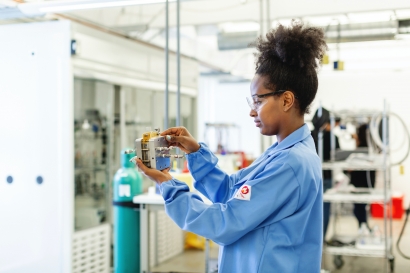
The single-step process is designed to use renewable electricity, and thus also provides a way for long-term storage of excess wind and solar power. The twelve-month research and development effort was funded by SoCalGas and PG&E and builds on the success of an initial feasibility study in 2018.
Raw biogas is produced from the anaerobic breakdown of waste from sources like landfills, sewage, and dairy farms. It contains roughly 60% methane (the main component of natural gas), and 40% carbon dioxide. While current biogas upgrading technology removes the carbon dioxide from biogas, this new technology captures the carbon dioxide and converts it into additional renewable fuel.
The new demonstration shows that improved catalyst activity could speed reactions by five times and nearly double conversion efficiency, making the technology commercially competitive with other new biogas upgrading methods. The core technology was scaled up and tested using commercially available electrolyzer hardware. The next step will be to test this technology for longer periods at an existing biogas facility.
"This cutting-edge method of using renewable electricity to convert carbon dioxide in biogas to renewable natural gas in a single-step process is significant to SoCalGas," said Yuri Freedman, SoCalGas' senior director of business development. "As we work to meet California's ambitious climate goals, emissions-reducing innovations like these will help us protect the environment by providing a reliable carbon-neutral fuel."
"PG&E is deeply committed to meeting California's bold vision for a sustainable energy future in a reliable and cost-effective manner for customers. We continue to work toward advancing innovation that provides new possibilities in our quest to reduce greenhouse gas emissions and find alternative sources of carbon-neutral fuel. We are very proud to be part of this collaboration with Opus 12 and SoCalGas," said PG&E's Manager of Innovation and Research and Development, Francois Rongere.
Opus 12, a clean-energy startup with its origins at Stanford University and the prestigious Cyclotron Road program at Lawrence Berkeley National Lab, has created a new proprietary Polymer Electrolyte Membrane (PEM) electrolyzer that uses electricity to convert water and carbon dioxide into renewable natural gas in one step. The technology differs from those that use microorganisms.
The research is part of SoCalGas' and PG&E's respective development of cutting-edge technologies for storing excess renewable energy. Because gases can be easily stored for long periods of time using existing infrastructure, these technologies have distinct advantages over storing renewable electricity in batteries.

